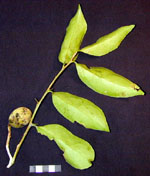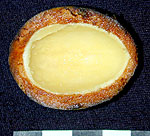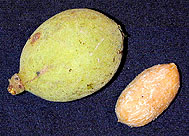 |
QUICK SEARCH
MO PROJECTS:
Africa
Asia/Pacific
Mesoamerica
North America
South America
General Taxonomy
Photo Essays
Training in Latin
America
MO RESEARCH:
Wm. L. Brown Center
Bryology
GIS
Graduate Studies
Research Experiences
for Undergraduates
Imaging Lab
Library
MBG Press
Publications
Climate Change
Catalog Fossil Plants
MO DATABASES:
W³MOST
Image Index
Rare Books
Angiosperm
Phylogeny
Res Botanica
All Databases
INFORMATION:
What's New?
People at MO
Visitor's Guide
Herbarium
Jobs & Fellowships
Symposium
Research Links
Site Map
Search
Acanthosyris annonagustata (Santalaceae), a new species from eastern EcuadorCarmen Ulloa Ulloa and Peter Møller Jørgensen
Summary. A new species, Acanthosyris annonagustata C. Ulloa & P. Jørgensen, from Napo, Ecuador is described and illustrated. This species is characterized by its golden brown puberulent inflorescence and fruit. The plant is used in local medicine, the fruits taste like Annona, and are eaten by monkeys. In Ecuador, Acanthosyris is also represented by A. glabrata (Stapf) Stauffer from the dry western forests, a tree which we are also reporting for the first time from Peru. Resumen. Se describe e ilustra la nueva especie Acanthosyris annonagustata C. Ulloa & P. Jørgensen (Santalaceae) de la provincia de Napo, Ecuador, que se caracteriza por tener las inflorescencias y frutos pardo-dorado puberulentos. La planta es medicinal, los frutos tienen sabor a Annona y son comidos por monos. En el Ecuador Acanthosyris también está representado por A. glabrata (Stapf) Stauffer, un árbol de los bosques secos occidentales que además se cita por primera vez para Perú. The genus Acanthosyris (Martius & Eichler) Grisebach in Ecuador was known only from the type collection of Acanthosyris glabrata (Stapf) Stauffer made by Baron von Eggers at “Hacienda El Recreo”, province of Manabí in 1893. The “Hacienda El Recreo” is the type locality of several species, located north of the town of Bahía de Caráquez, between San Vicente and Canoas, and in 1977 only an abandoned house was left by the beach (H. H. Iltis, pers. comm.). A century after the publication of this species in the genus Cervantesia Ruiz & Pavón, we saw the isotype at the U.S. National Herbarium and could therefore identify several recent collections from Ecuador and northern Peru, most of this material being misidentified as Ximenia (Olacaceae). Acanthosyris glabrata is also known from two Peruvian collections, Lao 5153 (MO) and Vargas 9 (F, MO) from the department of Tumbes. During the preparation of the Santalaceae for the Flora of Ecuador, we have studied specimens from Guayas, Manabí, and Loja provinces. Acanthosyris glabrata is also known from the department of Atlántico in northern Colombia. This species grows in dry forests from near sea level to 500 m elevation. Nee (1996) published a key of the woody Santalaceae for South America and described A. asipapote M. Nee from Santa Cruz, Bolivia. Recent collections of an edible tree from the Amazonian province of Napo, Ecuador have revealed a new species of Acanthosyris, making six the total number of species presently known in the genus. Acanthosyris is a South American genus of more or less spiny shrubs and trees, with edible, drupaceous fruits, distributed from Colombia to northern Argentina, Uruguay, Paraguay, and Brazil. In Ecuador it is represented by two species which can be separated by the following key: 1. Fruit ca. 2 cm long, glabrous, smooth; flowers whitish-gray velutinous, rachis whitish-gray villous; leaves ovate; young leaves sparsely villose on the midrib and petiole below; old twigs with exfoliating bark; Pacific dry forest ..... A. glabrata 1. Fruit 2.9–4 cm long, densely puberulent, rugulose; flowers and rachis golden-brown puberulent; leaves elliptic; young leaves glabrous or rarely with a few minute hairs on the midrib and petiole below; old twigs with striate bark; Amazonian rainforest ..... A. annonagustata Acanthosyris annonagustata C. Ulloa & P. M. Jørgensen, sp. nov. TYPE: ECUADOR. Napo: Parque Nacional Yasuní, carretera y oleoducto de Maxus en construcción km 20, 250 m, 28–30 Jul 1993 (fr.), M. Aulestia & G. Grefa 232 (holotype QCNE, isotypes AAU, GB, MO, US). Fig. 1. Arbores 30 m altae, spinosae. Folia elliptica, 5–15 cm longa, 2.1–6.8 cm lata, glabra, petiolis 4–9 mm longis. Inflorescentia spicata 2.1–6.8 cm longa. Flores extus trichomatibus fulvis dense puberuli, tepalis 5 (6), 2.0–2.5 mm longis, staminibus 5 (6), nectario 5 (6)-lobato, lobis 1.5–1.8 mm longis. Fructus drupaceus, 2.9–4 cm longus, trichomatibus fulvis dense puberulus. Tree to 30 m tall, 30–45 cm diam.; old branches with light brown or whitish gray, thinly striate bark, spiny; twigs drying dark brown, finely striate, and angulate, spiny; spines one or two per leafy twig, 4–10.1 mm long, axillary to a leaf and subtending an axillary bud. Leaf blades elliptic, 5–15 x 2.1–6.8 cm, acute to acuminate at apex, acute to attenuate and slightly decurrent at base, margin flat to slightly revolute, papery when young, chartaceous when mature, glabrous with a few scattered hairs on the midnerve and petiole when young, soon glabrescent, above drying brown or olive, lustrous, below dull, midnerve impressed or flat above, raised and rounded below, secondary lateral nerves 4–7 per side, raised on both surfaces, tertiary venation reticulate, visible on both surfaces; petiole 4–9 mm long, flat to slightly canaliculate above, rounded below. Several spikes generally clustered at the base of young branches, or 1 or 2 below the leaves, 2.1–6.8 cm long, rachis densely golden brown puberulent in the upper half, glabrescent, dark brown and lustrous towards the base, 14–24 flowered, bracteate; bracts 1.5–2.5 mm long, sparsely to densely puberulent. Flowers campanulate, greenish-cream, 5–7 mm in diam., densely covered with minute golden brown hairs on the outside; the tepal lobes 5 (6), triangular, 2.0–2.5 mm long, glabrous within except for a central tuft of long hairs with sticky tips that adhere to the adaxial side of the stamens; stamens 5 (6), opposite the tepals, 1.3–1.5 mm long, inserted near the base of the tepals, filaments flat, tapered towards the anther; nectary with 5 (6) oblong lobes alternating with the tepals, 1.5–1.8 mm long, minutely puberulent; style 1.2–1.8 mm long, stigma trilobed. Infructescence rachis to 8.5 x 0.4 cm, glabrescent, striate; fruit drupaceous, obovoid to ellipsoid, 2.9–4 x 2.2–2.8 cm, yellow or orange-yellow, crowned by the remains of the tepals, nectary and style, which form a depressed scar ca. 3 mm diam., the exocarp woody, 3–4 mm thick, the outer surface minutely granulose, densely covered with golden brown hairs ca. 0.25 mm long, mesocarp white or light orange; seed single, obovoid, to 3.2 x 1.6–1.8 cm. Paratypes. ECUADOR. Napo: Parque Nacional Yasuní, carretera y oleoducto de Maxus en construcción km 40, Parcela permanente No.10, 235 m, 10 Dec 1994 (fr.), M. Aulestia 2987 (QCNE); km 46, 244 m, 17 Sep 1993 (fr.), A. Dik 522 (COL, F, MO, QCNE, USM); km 10–12, 250 m, 10 Jul 1993 (fr.), G. Tipaz 2724 (QCNE); Reserva Etnica Huaorani, carretera y oleoducto de Maxus en construcción km 67–69, 250 m, 1–3 Dec 1993 (fl.) M. Aulestia, N. Andi & E. Nenquerei 1318 (AAU, COL, GB, MO, QCA, QCNE, US, USM); km 92–96, 250 m, 20 Mar 1994 (fr.), M. Aulestia & O. Gonti 2053 (LPB, MO, NY, QCA, QCNE, S). Etymology, common names, and uses. According to Dik 522 the fruit is very sweet and with a taste of “Guanábana” (Annona muricata L.), hence the name of this new species. The Huaorani Amerindians call it “Aguencatue” (Aulestia & Gonti 2053) or “Oreclamohue” (Aulestia et al. 1318), and prepare a tea to eliminate intestinal worms (Aulestia et al. 1318). Distribution, habitat, and dispersal. This species has been collected in eastern Ecuador along a road opened by an oil company in the Amazon rain forest at the Yasuní National Park and Huaorani Ethnic Reserve, Napo province, at ca. 250 m elevation. Material in flower has been collected in December and in fruit in March, July, September, and December. This new species is common in the area where spider (Ateles) and woolly (Lagothrix) monkeys feed on the fruits, and presumably are the principal seed dispersal agent (D. Neill, pers. comm.). According to Dawson (1944) fruits of the Argentinean species of Acanthosyris are eaten by mammals and birds, but seed dispersal has not been verified. Fruits of A. glabrata are relished by agouti (Dasyprocta) (Smith 1950) and the fruits of A. asipapote are generally eaten by wild animals (Nee 1996). As this new species has been reported having a tasty fruit, presumably other large Amazonian frugivores consume and dispersed it. Galo Tipaz, an Ecuadorian botanist, and his assistants germinated seeds as part of the revegetation of the Maxus pipeline road, and the plants were established in the revegetated areas of that road where at least some of the plants survived (D. Neill, pers. comm.). There is no documentation of hemiparasitism in this species, although it is probably a root hemiparasite as other species in the genus (Barroso 1968) and the family (see Kuijt 1969). Acanthosyris annonagustata is characterized by its elliptic leaves and golden brown puberulent inflorescence and fruits. It is the only species that has pubescent fruits when mature. These are medium size in the genus: A. asipapote and A. paulo-alvinii G.M. Barroso from Brazil have fruits almost twice as large, while the other species have fruits generally less than 2.5 cm long. The inflorescence and flowers are similar to those of A. glabrata and A. asipapote, but the indument of the rachis, bracts and flowers is golden-brown in the new species, while whitish gray in A. glabrata, and ferrugineous (bracts) and pale (rachis and flowers) on A. asipapote. Furthermore some of the flowers of A. annonagustata have six tepals, stamens and nectary lobes while only five has been reported for the other species in the genus. The leaves are elliptic in A. annonagustata like in A. paulo-alvinii. This is the only species in the genus that grows in tropical rain forest and has fruits known to be eaten by monkeys.
Acknowledgements. We thank Roy Gereau for correcting the Latin description, Henk van der Werff for revising the manuscript, David Neill and Hugh Iltis for sharing their observations with us, and Job Kjuit and Michael Nee for their review comments. Barroso, G.M. 1969. Acanthosyris paulo-alvinii – uma nova espécie de Santalaceae. Anais Soc. Bot. Brasil (XIX Congresso Nacional de Botânica 1968): 107–109. Dawson, G. 1944. Las Santaláceas argentinas. Revista Mus. La Plata, Secc. Bot. 4(23): 1–80. Kuijt, J. 1969. The biology of parasitic flowering plants. University of California Press. Nee, M. 1996. A new species of Acanthosyris (Santalaceae) from Bolivia and a key to the woody South American Santalaceae. Brittonia 48: 574–579. Smith, A.C. 1950. A Colombian species of Cervantesia R. & P. Trop. Woods 51: 12–14. Text: Copyright Missouri Botanical Garden.
|
© 1995-2025 Missouri Botanical Garden, All Rights Reserved
4344 Shaw Blvd.
St. Louis, MO 63110
(314) 577-5100
Technical Support



